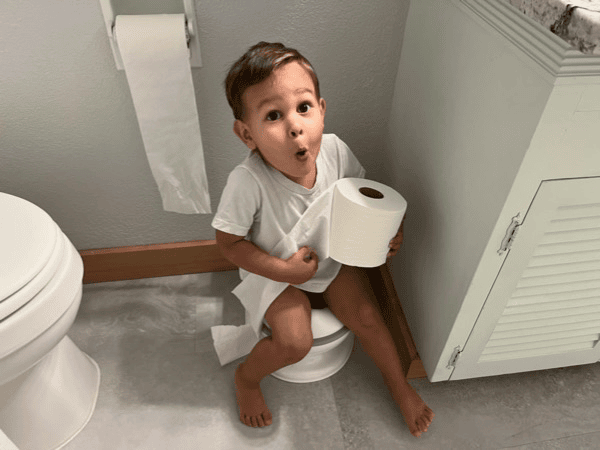
Muscles And Potty Training, What’s the Connection?
Red flags to spot once your child starts potty training, how to prevent poor habits from forming, and when to see a pelvic floor physical therapist
Believe it or not children can show signs of a pelvic floor dysfunction like adults AND show similar signs and symptoms. Pelvic floor physical therapy is for anyone with a human body… these are the muscles that hold up our organs and prevent them from falling out (literally)! Pelvic floor dysfunctions can occur when the muscles of the pelvic floor have lost the ability to properly contact or fully relax.
Symptoms in children tend to become noticeable once potty training begins and have the potential to linger into their teens/ adulthood if gone untreated. It is important to pay attention to behaviors and poor habits that could indicate your child is having a tough time on the toilet.
Here are some signs to look for in your child once the potty training process begins:
- Frequent urination (normal is every 2-3 hrs a day)
- Frequent accidents- especially when engaging in activities ie. monkey bars, running, playing with others
- Child complaining of painful urination or painful bowel movements or showing facial signs of cringing, wincing, grimacing
- Genital irritation or frequent itching, rubbing, or redness
- Straining, pushing, turning red in the face, clenching fists, pointing toes. These are all signs of a child with constipation or overworking to void
- Hypotonia – low muscle tone commonly seen in diagnosis of muscular dystrophy or downs syndrome
Prevention:
- Avoid telling your child to go to the bathroom just in case and provide lots of positive feedback for potty training. A regular voiding schedule is every 2-3 hours. It will be helpful to keep your child on a voiding schedule to avoid over distending the bladder
- Do not allow any distractions when using the potty (iPads, books, toys). Distraction often leads to not fully emptying their bladder. If the bladder is not fully empty this could cause increased tightness in the muscles and bacteria growth.
- Do encourage deep belly breathing; try having them sing songs, blow bubbles, or blow on a pinwheel
- Avoid letting your child’s feet dangle while sitting on the toilet (have them placed on a stool). This will cause the core and leg muscles to work too hard and not allow for pelvic floor muscles to relax to void
- Regular bowel movements. The rectum is a neighbor to the bladder and when too full it will push on the bladder causing increased sensation of urination and difficulty fully emptying the bladder.
Physical therapists can assist with your child’s pelvic floor by improving their quality of movements, muscle strength, muscle length and muscle coordination with functional play. What is functional play? This is a physical therapist’s way of disguising exercises and stretching to be FUN and ENGAGING. A child’s brain develops from the front to back; meaning treatments for an adult are not always suitable or effective for that of a child. Remember: Children are not small adults.
Knowing this potty training timeline can assist in communication with your child and understanding how to best meet their needs when participating in a physical therapy program.
The first part of a child’s brain to develop (birth-1 yr) after the brainstem is called the cerebellum. This portion of the brain wants to MOVE A LOT, dance, wiggle, roll and jump.
The second part of brain development is the occipital lobe (birth-2yrs), which is in charge of visual processing; adding interesting toys for visual tracking, visual instructions, visual models help stimulate this part of the brain.
Third to develop is the parietal lobe (birth-6yrs) for touch and language. Temporal lobe (birth to 6yrs) and the Limbic System (8mos to 2 yrs) is in charge of hearing, learning and emotions. Singing, reading, listening, holding objects, pushing, twisting, dropping, opening and closing items are all ways to stimulate this part of the brain.
The final portion of the brain to develop is the Frontal lobe – Concrete thinking (3-12 yrs) and Prefrontal Cortex – Judgment (12-22yrs). This part of the brain encourages problem solving, memory and planning. Giving choices, breaking down tasks, sticker charts, and noticing patterns are ways to help stimulate this part of the brain.
What to do when potty training today:
- See your pediatrician or a pediatric urologist to discuss possible contributing factors and to see if pediatric pelvic floor physical therapy is a good option for your child.
- Treat any underlying conditions (urinary tract infections, parasites, etc.) that may be affecting bowel and bladder function with the help of your doctor.
- Receive a referral for pediatric pelvic floor physical therapy and give Fusion Wellness and Physical Therapy a call to schedule an appointment.
References:
De Paepe, H et al. “Pelvic-floor therapy and toilet training in young children with dysfunctional voiding and obstipation.” BJU international vol. 85,7 (2000): 889-93. doi:10.1046/j.1464-410x.2000.00664.x
“Toilet Training: A Practical Guide.” Raising Children Network, 30 July 2020

